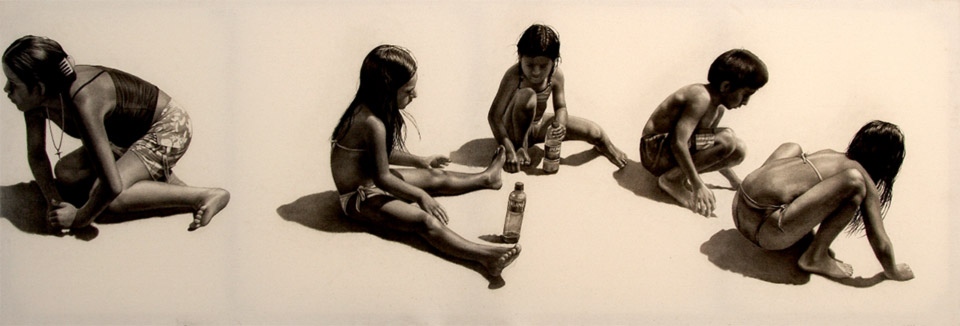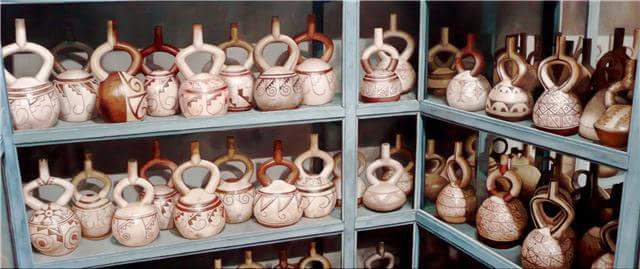Nostalgia is like looking in the mirror and having your childlike reflection staring back at you; that’s the feeling that overtakes you with Pablo Patrucco’s paintings. The Peruvian painter presents a softer view of Lima and its people, and because he comes from a long line of painters, he has an innate understanding of his environment’s artistic representation. “In my case, it wasn’t difficult to notice [I wanted to be a painter]. I come from a medium that was familiar to me, in relation to art and literature. My mom is a painter, so was her mom, and my sister is a painter too,” he says.
Over the past 15 years, the city of Lima has been undergoing major changes socially, politically, and structurally, and all of these embody a constant shift that affects its residents and others’ perceptions of what life in Lima really is. The investment of foreign companies in the region, the massive migration of people from the provinces to the city, and the lack of public housing and transportation budget/implementation have all contributed to an inevitable collective transformation.
These changes are steps in a positive direction in developing nations like Peru. There is modernity within the city, but the newness is simply external and superficial. When it comes to the people who live there, these shifts can surely affect their daily lives and many times they have no choice but to go along with them to survive. With so much social and historical richness in Peru, modernity can’t surpass these foundations, including the blend of Incan culture and colonial architecture, which is what Patrucco’s work is showing us. His paintings focus on the natural state of the landscape, especially the beach, which is a big part of Lima’s culture, its food, its people, and lifestyle.
Patrucco explains, “I’m a painter who is influenced by his surroundings, and the disorganization of Latin American cities is something that fosters my work. In my case, Lima, where I’m from, had stopped being portrayed for at least 15 years. It has grown a lot since and in a very disorderly manner. I think that along with other artists of my generation, we have been faced with the challenge to reflect on that in a creative manner, but at the same time interesting enough to find a coherent and meaningful discourse.”
His work indeed shares a level of awareness to what is currently happening in Lima, which has become overcrowded with housing, buildings, people, and even cars. Patrucco’s work holds a suspension of nostalgia that comes from the people portrayed, who seem to be trying to adapt to all these changes while holding on to something precious to them; peace and tranquility. In the paintings, they achieve this state of mind by being with friends and family, or through simply being present in that moment while appreciating the simple things in life that bring joy.
The paintings are in very soft colors, which serve as a symbol for the emotions behind the setting, like a peacefulness of being at the beach even though there’s so many people there, there’s a cohesive sense of collective peace for the people portrayed.
When living in a changing city since there’s no time to stop and smell the roses, which is essentially what his paintings are doing. They are forcing the viewer to look at the details of the moment and grasp the experience. A little girl grasping her wet bathing suit while looking into the distance, a man staring at the sea of people at the beach, including the beach goers and churro boy. These among other examples create a sense of peace within themselves vs. their environment.
Patrucco uses with oil paints on canvas and the black and white is pencil on canvas. When asked about his process, he says, “When you first begin, you try to find your own voice in a sufficiently impactful and different manner. Then, you notice that what matters most is being able to work all the time while nourishing yourself with the small things in life and most of all to enjoy the process and not detach your soul or exercise your inner self to do it, but to work in a disciplined and coherent manner.”
Patrucco’s paintings force the city dweller to stop and smell the roses; something a city resident often doesn’t have time for. They are forcing the viewer to look at the details of the moment and grasp the experience. A little girl grasping her wet bathing suit while looking into the distance, a man staring at the sea of people at the beach, including the beach goers and the ice cream boy. These among other examples create a sense of peace within themselves versus their environment.
The paintings are in very soft colors, which serve as a symbol for the emotions behind the setting, like a peacefulness of being at the beach even though there’s so many people there, there’s a cohesive sense of collective peace for the people portrayed.
For more of the artist’s work, please check out his website. This interview was translated from Spanish.
Today’s poem is inspired by Pablo’s depth of emotion surrounding Lima, a city by the sea:
MAR
By Luis Hernández
Entre la sombra voy
Juan Ramón Jiménez
1
REFLEJOS SOBRE EL AGUA
Las franjas suaves del agua
se pierden en la orilla.
– Es posible vivir;
está húmedo el aire
y reseca la arena….
– El viento trae gotas
fugaces y salinas.
El mar antes surgía,
sereno sin ser visto,
mi amor por él, ahora,
olvidará hasta el cielo.
El agua antes cantaba
infiltrada en la arena;
hoy, la busco hasta a ella
por el mar no saciado.
Ayer vimos las ondas
que subían perfectas,
hoy
nuestros pies las perturban,
nuestros cuerpos las quiebran,
Está el mar muy amargo,
hemos bebido
en un día sus aguas,
pisado sus riberas.
2
La última onda,
limpia y azul,
ha caído tan cerca
de mí
que puedo sentir
su pensamiento.
3
Vuelvo mi rostro,
arriba…
abajo en el fondo
pétreo y salino del pozo,
oriónidas estrellas
se hunden en la noche.
y 4
He cubierto en el mas
el vacío
entre estrella y estrella
creyéndolas mías;
mas la noche muere
y estoy tan solo
como antes.










